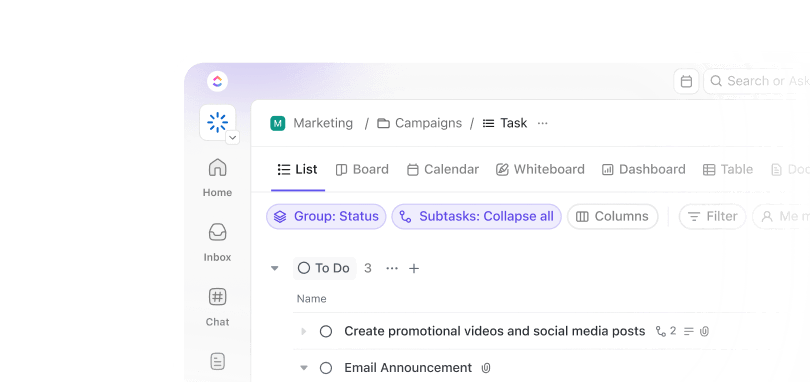Some days, it may feel like you and your coworkers are stuck in a workplace version of charades. Teammates dodge your questions with vague responses or hit you with cryptic replies that leave you wondering if you missed a memo—or just their mood.
Welcome to the world of passive communication struggles!
In fact, a recent survey found that 83% of Americans encounter passive-aggressive emails from their own coworkers.
It’s just one of the many hallmarks of passive communication styles that can make tackling tough conversations and building group cohesion tricky.
But fear not! Understanding these subtle signals and adopting assertive communication techniques can clear the air and foster a more open and honest workplace.
Let’s explore how to handle passive communication at work and transform those murky interactions into clear, effective dialogues.
How to Handle Passive Communication at Work
⏰ 60-Second Summary
- Passive communication often involves avoiding the direct expression of thoughts, feelings, or needs, leading to misunderstandings and frustration
- Key signs include vague responses, conflict avoidance, and nonverbal cues like poor eye contact or over-apologizing
- Passive communication can create tension, reduce team morale, and lead to poor performance. Over time, it damages both personal and professional relationships
- To spot early signs, watch for unclear communication, silent agreements, and resistance to speak up during key moments
- Tools like help manage communication with clear task assignments and real-time collaboration, improving transparency and accountability
What Is Passive Communication?
Passive communication is all about avoiding direct expression of thoughts, feelings, or needs. While it might seem polite or harmless, it often leads to misunderstandings and unmet expectations. Here are its key traits:
- Reluctance to assert needs: Passive communicators often go along with things, even when uncomfortable, to appear agreeable. However, this can lead to a growing list of unmet needs
- Avoiding conflict at all costs: Rather than addressing issues head-on, they might stay silent or agree to things they’re uneasy about to “keep the peace”
- Unclear or vague communication: Opinions or desires are often shared in half-hints or left unsaid, causing confusion among colleagues or teammates
Do these sound familiar? Don’t worry—it’s fixable! Recognizing these habits is the first step toward better communication.
The impact of passive communication in the workplace can be more harmful than you think. When it takes over, it affects the whole team, not just one colleague.
Keeping thoughts and feelings to yourself can cause tension, confusion, and poor performance. A clear communication plan fosters a positive work environment, reducing misunderstandings for everyone. Let’s look at the impact in detail:
Personal and professional impact
When communication isn’t clear or direct, the effects don’t always appear immediately. But the longer passive communication goes unchecked, the more damage it can do.
Take this scenario: a project manager avoids giving crucial feedback to their team. At first, it seems harmless enough.
However, the developer working on a key feature has no clue if their work aligns with the project’s goals. Weeks roll by, and suddenly, the feature is way off track, leading to delays and rework. The manager’s hesitation to speak up causes frustration across the team.
This cycle of ignored needs and unspoken concerns can spiral into a toxic environment, sapping team morale and productivity. In fact, research shows that unclear communication can lead to a 34% drop in job satisfaction.
Over time, this builds up, creating conflicts and damaging both professional and personal relationships. Not exactly the recipe for success, right?
Negative effects on team dynamics
The real impact of passive communication truly shows up in team dynamics. When one person holds back their thoughts or avoids confronting issues head-on, it creates a breeding ground for miscommunication.
Imagine a product design team where one member notices a design flaw but keeps quiet to avoid confrontation. The issue goes unnoticed, snowballing into bigger problems that cause delays and expensive fixes down the road.
This is where workplace communication tools could have saved the day. When team members aren’t clear about their needs or concerns, it’s easy for the whole group to veer off track, causing a dip in trust and morale.
📮 Insight: 37% of workers send follow-up notes or meeting minutes to track action items, but 36% still rely on other, fragmented methods.
Without a unified system for capturing decisions, key insights you need may get buried in chats, emails, docs, or spreadsheets. With , you can instantly turn conversations into actionable tasks across all your tasks, chats, and docs—ensuring nothing falls through the cracks.
Recognizing Passive Communication in the Workplace
Ever wonder if it’s a sign of passive communication or your mind’s playing tricks on you? Identifying passive communication may not come easy initially, but once you know what to look for, it’s easier to spot. Here they are:
- Nonverbal cues: Avoidant body language like no eye contact, slouched posture, or tense facial expressions often signal discomfort and a reluctance to speak up
- Vague responses: Phrases like “I guess” or “It’s fine, I think” avoid clear stances, leaving others unsure of their genuine opinions
- Conflict avoidance: Passive communicators often stay silent in discussions or dodge disagreements, even when their input is crucial
- Over-apologizing: Constant “sorry,” like “Sorry to bother you,” reflect low confidence and fear of imposing or conflict
- Tone of voice: Hesitant or overly soft tones suggest a lack of assertiveness, sometimes paired with subtle, passive-aggressive remarks like “Sure, whatever you think is best.”
👀Did You Know? About 30% of workers have said miscommunication has affected their self-esteem and professional confidence. 22% of these workers have considered switching jobs because of poor communication.
How to tell if you are a passive communicator
But wait—are you a passive communicator? Look for these signs in your own behavior. Do you agree to things even when you don’t have the time or energy to avoid saying “no”?
Maybe you stay quiet during discussions, even when you have something valuable to add. Or perhaps you use phrases like “I think” instead of being direct with your opinions. If you catch yourself apologizing for things that don’t require an apology, that could also be a sign.
If these patterns sound familiar, let’s examine how you communicate. Recognizing these signs is the first step toward fostering clear, direct, and productive conversations—while building the confidence to communicate more assertively at work.
Examples and Common Situations of Passive Communication
Effective communication is essential in any workplace—it drives collaboration, resolves conflicts, and strengthens relationships.
But not everyone communicates openly. Some individuals adopt a passive-aggressive communication style, which can hinder team dynamics. Here are some examples and everyday situations of passive communication:
- Emma agrees to work late without expressing frustration and avoid confrontation. However, it leads to internal resentment, which strains the team over time
- Tom remains silent in a meeting when he believes a colleague’s idea will fail, risking harm to the project and his credibility by not speaking up
- Mia struggles with a heavy workload but doesn’t voice her struggles to her manager, leading to burnout and missed opportunities for support
- At a brainstorming session, Kevin has an innovative idea but hesitates to share it, fearing judgment from teammates, which stifles creativity and hinders team progress.
These examples show how different workplace communication styles can hold people back.
Strategies to Overcome Passive Communication
Handling passive communication requires awareness and action. Recognizing it—whether in yourself or others—helps create a healthier communication culture. Here are four strategies to address it effectively:
Encourage assertiveness
To encourage others to adopt an assertive communication style, lead by example by being clear and respectful with your team. Many find openly expressing their needs without causing conflict daunting. Build avenues for open dialogue to tackle this.
This helps passive communicators—especially those who avoid conflict—feel more comfortable speaking up. These benefit teammates who deal with a social anxiety disorder, too.
By setting the tone for healthy communication, you create a space where everyone feels heard and can contribute to discussions without hesitation or fear of confrontation.
Provide communication training
As remote teams become more prevalent, the risk of miscommunication grows, mainly depending on the medium used.
Our recent study reveals that 42% of team members still rely on email for communication, while 41% use instant messaging. This difference in preference may also lead to misunderstandings, cold-sounding emails, or unprofessional texts. Providing training to improve communication skills over technology and face-to-face can help mitigate these issues.
Pro Tip: Leverage AI tools to fine-tune your emails and messages to ensure that they’re polite but assertive. For instance, Brain, ’s built-in AI assistant, can easily help you do this with the right prompt. Here’s an example.

Set clear expectations
When you have roles and responsibilities clearly outlined, it’s easy to prevent misunderstandings and foster open communication.
Outlining expectations on the front end can minimize team confusion, and passive-aggressive behavior is less likely to arise. People who are uncertain about their roles may avoid taking responsibility, but clear guidelines keep everyone aligned.
Using tools like the RACI Planning Doc Template helps define who in the team is Responsible, Accountable, Consulted, and Informed for each task.
This template helps ensure team alignment with project goals, builds accountability, and identifies potential risks.
Promoting feedback and recognition
Promoting feedback and recognition in the workplace can improve communication. Regular feedback helps team members understand their progress and areas for improvement, while recognition boosts morale and reinforces positive behaviors.
When a passive communicator speaks up, acknowledge their contributions with positive reinforcement. Simple statements like, “Thank you for sharing, that’s a great point,” can help build confidence over time.
Passive communication decreases with better feedback, creating a more open and supportive environment.
Managing passive communication at work can be challenging. Navigating complex dynamics and personalities requires awareness, clear communication, and the right tools. While technology can’t fix everything, it can help streamline communication and manage feedback effectively.


One powerful platform to help manage these issues is . The everything app for work is designed to improve team communication and task management. Whether you’re a small business or a global team, makes managing expectations easier with its versatile tools.
It helps set clear goals and manage team expectations via Goals. You can then break down each goal into tasks and sub-tasks, assign them to specific team members, create checklists, and more within the task to make sure that there’s no room for ambiguity or misunderstandings rising the same.


Further, feedback loops are built-in with Tasks, allowing managers and team members to offer real-time, constructive input and ensuring everyone stays on track. ’s task history feature also ensures accountability by tracking all changes and fostering trust between team members.
One way the platform does this is through the Collaboration Detection feature that lets you see what your team is up to in real time. All comments and tasks can be viewed by your team members instantly, reducing miscommunication and promoting transparency.
This feature emerges as a hero on Docs. It ensures collaboration is fully live and transparent and keeps documentation in one place.


Chat takes this to the next level. Bid goodbye to fragmented chat apps and bring your discussions to the platform that also houses your work.
Eliminate any chances of missing major updates—or worrying about whether it’s professional to text your team email or chat—and turn your conversations into actionable tasks with a click within a single, integrated platform.


You can also work with ’s Assign Comments feature to instantly assign tasks to yourself or your team and resolve them when done—all while leaving the breadcrumbs of who worked on what and when.


Views is another feature that champions team communication. It lets you and your team members visualize the workflows in a way that makes the most sense to you, with 15+ options to choose from.
For instance, the intuitive drag-and-drop functionality of the Board View can help you keep tasks organized and in place. Another great view to ensure fair workload distribution is ’s Timeline view. It helps you assess individual tasks, prevent burnout, and balance responsibilities.
These tasks are also neatly organized in a hierarchical system of Spaces, Folders, and Lists—these help you never lose track of your progress and work priorities!
Finally, also offers a variety of ready-made templates, including feedback forms and communication templates, to help with smooth communication across teams.
For teams struggling with passive communication, ’s Communication Plan Template helps foster proactive collaboration. This template makes creating a comprehensive project communication plan easier by helping you outline and implement clear messaging strategies.
Using this template, you can:
- Enhance communication within the team and with external partners
- Structure communication objectives, goals, timelines, and key stakeholders
- Ensure consistent communication across all departments and teams
The template streamlines internal and external communications, empowering teams to stay accountable and avoid passive communication habits.
Improve Team Communication and Boost Collaboration With
When working with passive communicators, it’s crucial to remember that their behavior is often driven by fear; it does not reflect your value. While you can’t change their approach, you can control your response.
Tools like help with transparency and clarify roles and responsibilities without conflict. Features like task tracking and real-time collaboration promote active participation, helping reduce passive behavior.
But don’t forget: A manager who fosters an open communication channel can effectively overcome passive communication issues.
Ready to take the first step towards better communication? Sign up for for free today and get your team engagement going!


Everything you need to stay organized and get work done.














